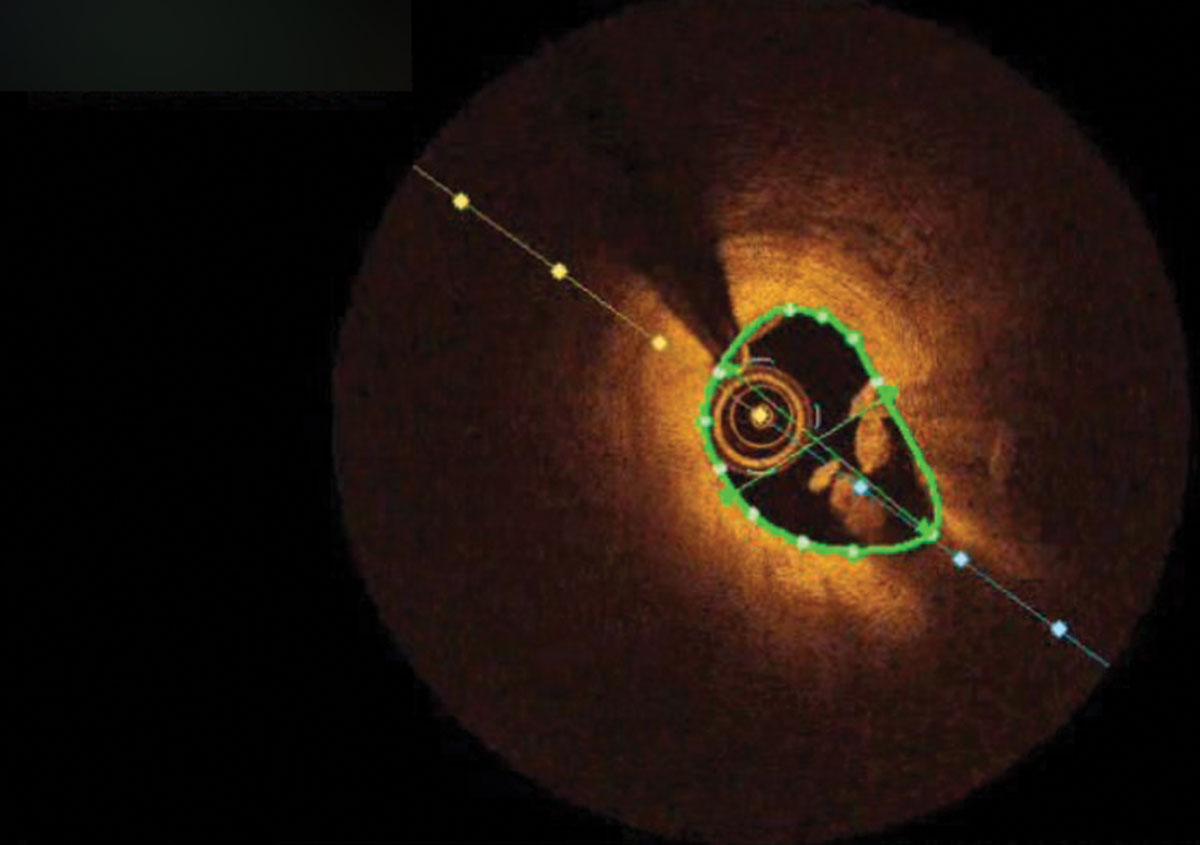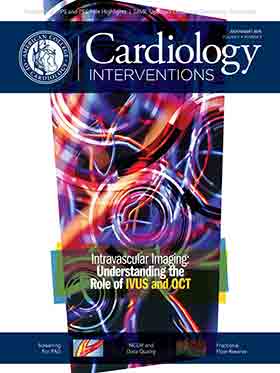For the FITs | Intracoronary Optical Coherence Tomography (OCT) For the Interventional FIT
Figure 1: Left anterior oblique caudal (“spider”) angiogram demonstrating a 90 percent circumflex stenosis and an indeterminate lesion in the ramus intermedius visually estimated at 60 percent stenosis. (Click image for a larger view.)

Intracoronary imaging continues to increase in use as both a diagnostic and intervention tool for PCI guidance. The decision to use optical coherence tomography (OCT) or intravascular ultrasound (IVUS) is sporadic in most institutions due to a lack of data from prospective clinical trials, added procedure time and possibly user unfamiliarity with the techniques.
In acute coronary syndrome (ACS), in particular, there is added benefit in cases where the culprit lesion is ambiguous on angiography.1 In ILUMIEN III: OPTIMIZE PCI, a prospective, multicenter study that randomized 450 patients undergoing PCI to OCT, IVUS or angiographic guidance, OCT was noninferior to IVUS guidance but not superior to either IVUS or angiographic guidance.2 The ILUMIEN IV trial, using the same algorithm for OCT-guided PCI, seeks to determine if there is improvement in clinical outcomes of 2,500 patients with high-risk clinical or high-risk angiographic characteristics.3
The comparison between OCT and IVUS does not show a clear winner in all circumstances and instead the favored modality tends to be situational. Image acquisition is faster and with higher resolution using OCT. The higher spatial resolution of OCT offers greater detail of near field tissue characteristics such as calcium, thrombus and neointima. This is an advantage when assessing stent apposition, strut coverage, tissue prolapse and edge dissection.
The higher resolution and the contrast between the lumen and vessel wall obtained with OCT allow for a more detailed lumen segmentation compared with IVUS. This is most apparent in irregular, calcified plaque. IVUS, on the other hand, has greater depth of penetration and is preferred for larger vessels such as left main or aorto-ostial lesions. Of note, blood must be displaced in order to use OCT, but this is not a requirement for IVUS.4 For interventional fellows, familiarity and fluency with these techniques are of increasing importance. OCT has application to both diagnostic and interventional situations.
Clinical Case
A 55-year-old man with a history of coronary artery disease status post PCI to the left anterior descending (LAD), left circumflex (LCx) and left main three months ago presented with several weeks of chest pain. He described intermittent substernal burning chest epigastric discomfort that was sudden and different from prior hospitalization, which he attributed to anxiety. His admission ECG had no ischemic changes and initial troponins were negative, however, stress echo showed evidence of ischemia in the apical-anterior myocardium. Diagnostic catheterization revealed patent stents in the LAD, LCx and left main, with a 90 percent lesion of the LCx as well as a “hazy” lesion of the ramus, which was visually estimated as a 60 percent stenosis.
Operators decided to investigate the ramus lesion with OCT, which demonstrated a minimal luminal area (MLA) of 2.50 mm2, which was significant. Ultimately, the ostial circumflex was stented using a 2.5 x 9 Xience drug-eluting stent (DES) and the ostial ramus was stented using a 2.75 x 12 Xience DES with a good result and no complications.
When and How to Use OCT
Intracoronary imaging is an important tool for distinguishing stable coronary artery disease (CAD) and ACS. In this case, a visually insignificant lesion was determined to be significant and thus was stented. Therefore, OCT can help answer the question of lesion significance, whether it requires stenting and which lesion is most significant.
Both IVUS and OCT have the disadvantage of the inability to predict physiology. Interestingly, IVUS and OCT show concordance in reference to luminal area measurements. With particular relevance to ACS, OCT is considered the gold standard method for fibrous cap rupture detection and has twice the sensitivity of IVUS in this capacity.1 Moreover, in non–CAD-related ACS causes like spontaneous coronary artery dissection, OCT is useful. Nevertheless, the gold standard for physiologic measurements of the coronary remains fractional flow reserve (FFR).5
In addition to pre-intervention lesion planning, OCT and IVUS appear to have a function in stent sizing and deployment, particularly in assessing vessel dimensions. Post PCI, there is a use for surveillance of stents for deployment complications such as malapposition, edge dissection and tissue protrusion. Last, there may be a role for routine surveillance of bioabsorbable scaffolds as that technology continues to evolve.
Technical Aspects
The LightLab M2 TD-OCT Imaging System (LightLab, Westford, MA) is the first-generation system in commercial use. Images are recorded by an ImageWire (LightLab), which is a fiberoptic wire that rotates inside a fluid-filled polymer tube and is attached to an automated pullback engine integrated with the console. The external diameter of the wire is 0.019 inches that at the distal end is fused to a short segment of a 0.014 inch guidewire. Cystalloid solutions are infused through distal flush ports of an over-the-wire low-pressure occlusion balloon catheter manufactured by Helios (Nagoya, Japan). Blood must be completely removed because any amount of residual blood causes significant signal attenuation. Balloon occlusion time is limited by the manufacturer to 30 seconds.6
The next generation OCT ImageWire (Lightlab TD-OCT) is not a stand-alone device, but inserted with an over-the-wire balloon catheter with 6 French guiding wire over a conventional 0.014 inch guidewire. The guidewire is then exchanged with the OCT ImageWire, and the occlusion balloon is pulled back and repositioned in a healthy proximal segment. Contrast solution is injected through the occlusion balloon catheter and the pullback speed can be adjusted from 0.5 to 3.0 mm/second, and the entire wire is pulled distal to proximal along the artery. In this next-generation of OCT systems, imaging can be performed without balloon occlusion.6
MLA on OCT roughly correlates with FFR ischemic values in vessels other than the left main coronary. Because these MLA values have a high positive predictive value (80 to 92 percent) but lower negative predictive value (66 to 89 percent), they can be inaccurate in up to a third of cases, thus they are not yet recommended for decisions about PCI alone.7
Conclusion
Certainly, there are barriers to the adoption of OCT in clinical practice despite burgeoning evidence to support its use. Current data tends to favor OCT or IVUS over angiography depending on lesion characteristics, yet both have applicability in diagnostic and interventional procedures.8
Image data compilation can inundate the user and there is a lack of routine training in use and interpretation. Increased contrast load with OCT and expense may also be prohibitive in many cases.
Nevertheless, both imaging techniques are underutilized in everyday practice, hence the need for interventional fellows to understand and spearhead their use in clinical practice.

This article was authored by Christine DeStephan, MD, an interventional cardiology fellow at the University of Vermont Medical Center in Burlington, VT.
References
- Kubo T, Imanishi T, Takarada S, et al. J Am Coll Cardiol 2007;50:933-9.
- Ali ZA, Maehara A, Généreux P, et al. Lancet 2016;388:2618-28.
- Maehara A, Ben-Yehuda O, Ali Z, et al. JACC Cardiovasc Interv 2015;8:1704-14.
- Bezerra HG, Attizzani GF, Sirbu V, et al. JACC Cardiovasc Interv 2013;6:228-36.
- Nascimento BR, de Sousa MR, Koo BK, et al. Catheter Cardiovasc Interv 2014;84:377-85.
- Bezerra HG, Costa MA, Guagliumi G, et al. JACC Cardiovasc Interv 2009;2:1035-46.
- Ali ZA, Karimi Galougahi K, Maehara A, et al. JACC Cardiovasc Interv 2017;10:2473-87.
- D’Ascenzo F, Barbero U, Cerrato E, et al. Am Heart J 2015;169:663-73.
Clinical Topics: Acute Coronary Syndromes, Invasive Cardiovascular Angiography and Intervention, Noninvasive Imaging, Interventions and ACS, Interventions and Imaging, Angiography, Nuclear Imaging
Keywords: ACC Publications, Cardiology Interventions, Tomography, Optical Coherence, Acute Coronary Syndrome, Prospective Studies, Angiography, Percutaneous Coronary Intervention, Algorithms
< Back to Listings



